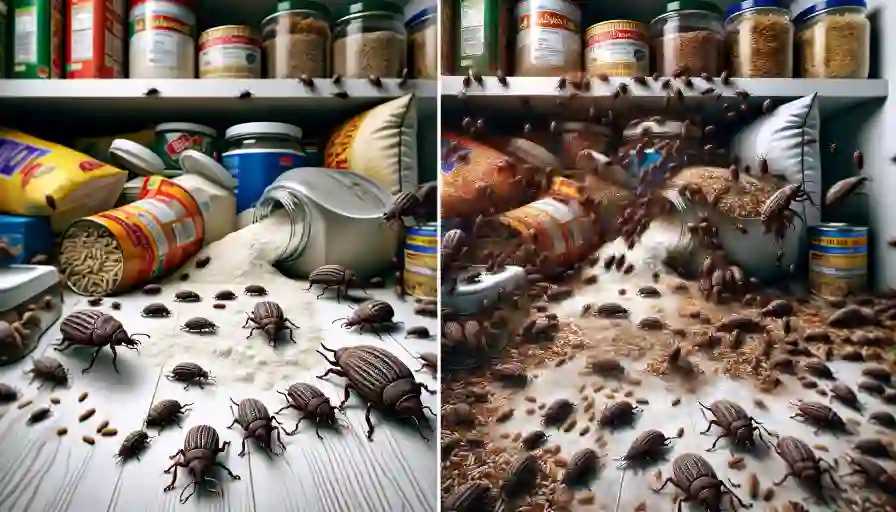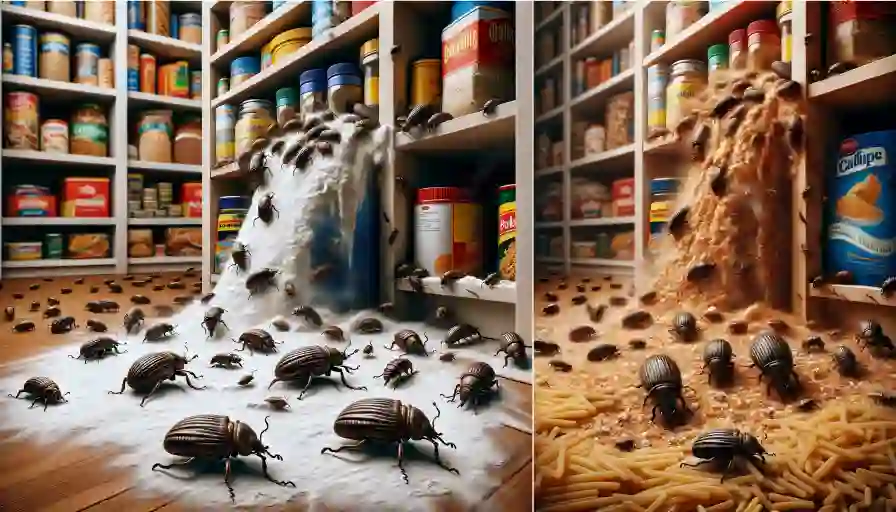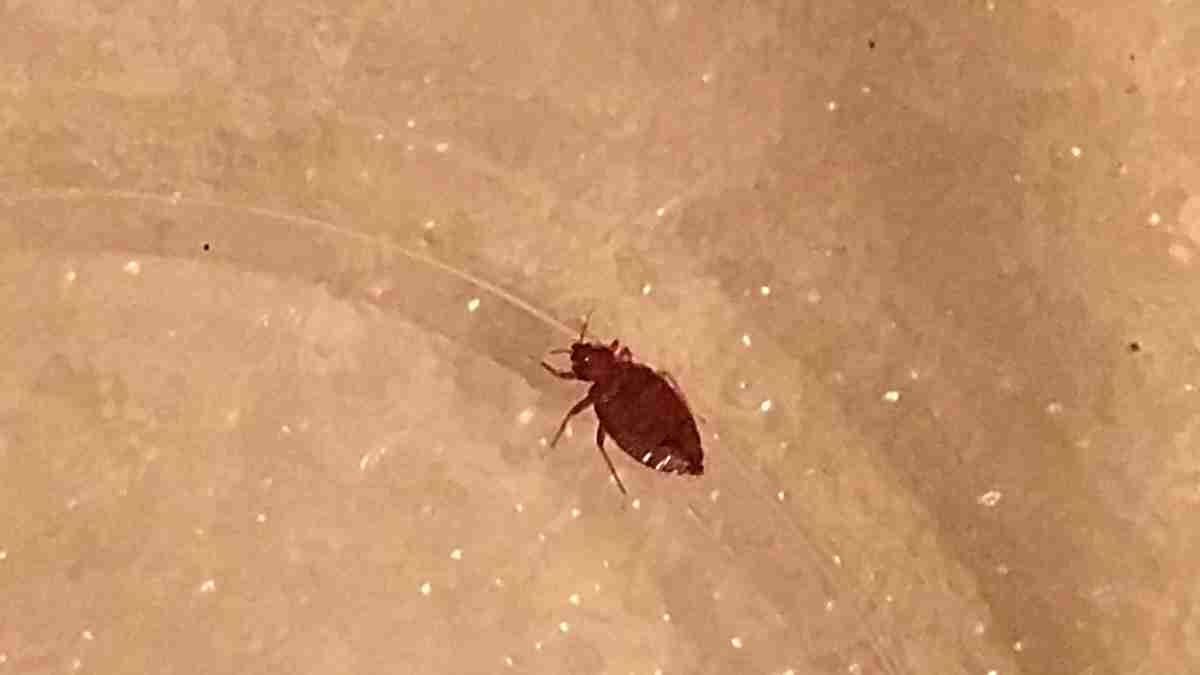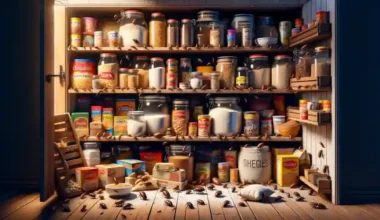You don’t want pantry weevils in your food storage as they are notorious for food contamination. They will feed on your grains or even discourage you from eating them since you will be uncomfortable consuming the bugs. While commonly referred to as flour bugs due to their frequent presence in flour, you can also find weevils in whole-grain cereals, grains, nuts, and beans stored in boxes or bags. Weevils are particularly attracted to products containing raw wheat, oats, rye, barley, rice, and corn. Now, you have to know how to get rid of pantry weevils to protect your storage goods.
In this guide, I will walk you through the steps to eliminate these pests from your pantry. Don’t worry, these will be simple methods that anyone can implement safely in their home.
What Do Weevils Look Like?
Pantry weevils are small, brown beetles commonly found in kitchens. They have a distinctive snout and are known for infesting dry goods like flour, rice, and cereals. Their bodies are oval-shaped, and they are usually about 2-3 millimeters in length. These weevils can be identified by their dark color and the way they move, which is often in a wiggling motion that resembles swimming.
Types of Weevils
According to the Entomology And Nematology Department, University of Florida, there are over 60,000 species of weevils known worldwide, and commonly found in pantries and cupboards. Yet, many of the species are still unknown to science.
These weevils are different from those that damage outdoor plants and crops. The types you might find in your pantry are:
- Granary or wheat weevils (Sitophilus granarius). These weevils can’t fly and are shiny red-brown, often found in cooler climates.
- Rice weevils (Sitophilus oryzae). These are flying beetles, dull red-brown with four light spots, more prevalent in warmer climates.
- Maize weevils (Sitophilus zeamais). Maize weevils closely resemble rice weevils, and only a detailed examination of their reproductive parts can distinguish between the two species.
What Attracts Weevils to Pantry?
Adult weevils seek shelter in homes, especially during hot and dry outdoor conditions. They enter through small openings or come inside with infested whole-grain cereal products purchased from stores. These products might have been contaminated during their processing and packaging. Weevil infestations are more likely in storage areas with lots of spilled foods and numerous partly used containers.
How to Get Rid of Pantry Weevils

So, how do we get rid of pantry weevils? I will show the steps you should follow to remove them from your home permanently.
1. Identify the Weevil Infestations in Your Pantry
Pantry weevils reproduce by creating a tiny hole in a grain or seed and laying a single egg inside. The entire development from egg to adult insect happens within the seed. Since a large part of their lifecycle is hidden inside the seed, and the adult weevils are quite small, you might not notice an infestation until it is widespread. Here are some signs to watch for:
- Active adult beetles appear when you use a grain product for cooking.
- Dusty residue floating on top of water when you soak stored grain.
- Numerous empty seed husks in the stored grain product.
- Dry, dusty residue from the hulls of seeds that were used for egg-laying, and as homes for larvae and pupae.
If a container of grain product seems unusually dry and dusty, it may be infested with weevils. Many of the seeds might still contain hidden larvae.
2. Discard Heavily Infested Foods
Is your pantry food heavily infested? Immediately seal and dispose of any open cereal-grain products if you suspect weevil presence. Also, discard nearby open containers. Be cautious with unopened cardboard packages as well, especially if their inner liners aren’t sealed. When dealing with weevils, err on the side of caution and aggressively discard any food you suspect might be infested.
3. Remove Any Adult Weevils
Once you have cleared out your pantry, and after getting rid of any questionable food items, vacuum the storage areas and clean them using hot soapy water or a disinfectant spray cleaner. Clean individual food cans and glass containers as well before putting them back. Make sure no adult weevils are left to start a new infestation.
4. Use Heat or Cold on Infested Foods
To deal with infested food, or if you are uncertain but want to attempt to exterminate the weevils, you can generally kill the adult weevils, eggs, larvae, and pupae by either heating the food to 140 degrees Fahrenheit for at least 15 minutes or freezing it at 0 degrees Fahrenheit or lower for three days.
5. Discourage Weevils with Natural Deterrent
You can use bay leaves, cloves, or garlic to get rid of pantry weevils. Place these leaves in your pantry or with your dry goods to help keep weevils away. It works for weevils in rice too.
Tips to Keep Pantry Weevils at Bay

- Inspection of newly purchased food items and periodic checks of cereal-grain products in your cupboards or pantries can prevent weevil infestations.
- Consider setting a limit on how long you keep partially used grain products, discard old ones, and buy fresh products regularly.
- You can also routinely freeze cereal-grain products for four days after buying them, transferring them to cupboard storage only after this precautionary step. Freezing kills any weevils that may be present in commercial packaging. You can also store these products in the freezer permanently if space allows.
- Avoid mixing new food with old, and always clean containers before refilling them.
- Store pet food, birdseed, and similar items in places separate from your house, like other buildings or basement areas that are distant from other food storage.
- Do not purchase food in bags or boxes if the packaging is torn or damaged.
- Avoid buying food products that are past their expiration dates.
- Only buy the amount of food you will use in a short time. If you have excess, store it in the refrigerator or freezer.
- Maintain cleanliness in your pantry and other food storage areas. Keep these areas free from loose food particles and crumbs, and clean spills immediately.
- Ensure food storage areas are dry, as weevils are attracted to moisture.
- Store grain products in sealed containers.
Before using the grains for cooking, inspect them carefully each time to ensure there is no insect activity.
Caution!
Never use traditional chemical insecticides on foods, surfaces, utensils, or other items that may come into contact with raw foods. Always read and follow the label instructions carefully, even when using products labeled as organic or non-toxic.
Contact Your Local Pest Professional for Weevil Infestations
If the problem is severe and you are unable to get rid of pantry weevils, contact a pest control service. They will investigate to find the source of the infestation, which may extend beyond your pantry or cabinets. Once they identify the main source, they normally use methods such as extreme heat or cold, specialized sprays, or other techniques to eliminate the weevils permanently.
Read Also: Bugs in Food Pantry [What to Do]





